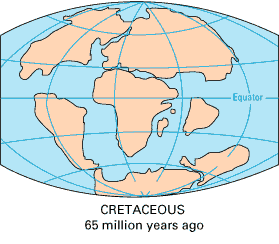
Posted on 10/21/2007 7:02:54 AM PDT by decimon
Yep, warmblooded. And, IMHO, covered with primitive feathers.
Dinosaurs, as depicted today, look like plucked chickens to me. I wouldn’t be surprised if this polar predator was black and white like a penguin.
I guess it was wearing leather shoes, that’s how they knew it was carnivorous.
Penguinosaurs
Bruno Magli shoes, that’s how they knew it was a killer...
LOL!
This explains why there are no polar bears in Antarctica...their ancestors were all eaten by Ozziesaurus.
Weren't dinosaurs cold blooded? (Now, tell me again how they evolved into warm blooded avians...)
Gorasaurus. Is that why he has to use more calories in life, including from iced tea, in everything he does, more than any other 10 given people, combined?
|
|
|||
Gods |
Thanks decimon. Shouldn't they be running for safety? Or aren't these tracks fresh? ;') |
||
|
· Mirabilis · Texas AM Anthropology News · Yahoo Anthro & Archaeo · · History or Science & Nature Podcasts · Excerpt, or Link only? · cgk's list of ping lists · |
|||
Researchers Melt Polar Dinosaur MysteriesThe first indication that there even was such a thing as polar dinosaurs came in 1960 when footprints were found at Spitsbergen, an island that lies about half way between the coast of Norway and the North Pole. Since the initial discovery, the study of polar dinosaurs has slowly gained momentum... Did the animals migrate to warmer climes during the worst of the winter, did they hibernate, or did they remain active close to the poles even during the coldest part of the year? How cold was it? It's not that easy to establish a region's mean annual temperature 150 million years ago... There has been some speculation as to whether polar dinosaurs lived in the high latitudes during the warmer months, and then either migrated to warmer climes or perhaps hibernated through the colder months... The dinosaurs on Alaska's North Slope wouldn't need to hibernate or migrate because the temperatures were much warmer than they are today. Researchers estimate that from about 90 million to 65 million years ago, temperatures on the North Slope probably ranged from a maximum of 55 degrees Fahrenheit (13 degrees Celsius) to a minimum of 36 to 46 degrees Fahrenheit (2 to 8 degrees Celsius).
by Hillary Mayell

 |
||
| · join · view topics · view or post blog · bookmark · post new topic · | ||
Northern Crater Shows Prehistoric Deep ImpactTo the rhinos and crocodiles of the far north, the day was like any other. They ate, swam and napped, unaware a celestial body was headed their way at 60,000 miles per hour. Suddenly, a wayward comet screamed into the atmosphere, struck Earth and created a bowl a mile deep and 15 miles in diameter.
by Ned RozellMars On Earth: Arctic Crater Reveals Martian Secrets (pt 2)Haughton Crater is the remaining scar from a high-speed collision between Earth and some heavy object from space about 23 million years ago. The comet or asteroid that created the crater was perhaps more than a mile (up to 2 kilometers) across and slammed into the forest that existed on Devon Island. Everything was annihilated for scores of miles in all directions. The impact churned up rock from more than a mile below the surface, vaporizing much of it. It's estimated that between 70 and 100 billion tons of rock was excavated from the crater in the moments just after the impact. While clouds of dust and gas filled the air, rock rained down from the sky, much of it in the form of what geologists now call breccia, which simply means "broken up." Scattered within the breccia are pieces of a rock called gneiss that normally is dark and dense. In Haughton Crater breccia, the "shocked gneiss" resembles pumice stone -- it's ash-white, porous and very lightweight.Voices of the Rocks"Yet, as it will, life returned to this site of complete devastation... The world those fossils described, the one that flourished on the order of 20 million years ago, during the early Miocene epoch, was strikingly different from today's Arctic... Devon Island was covered with a forest of birch trees and conifers, a landscape that one now finds about 2,000 miles to the south, in Minnesota, Wisconsin, and Maine. Now-extinct forms of rhinoceros and mouse deer browsed among the trees; shrews and pika-like relatives of modern rabbits darted through the shadows; and freshwater fish swam the lakes and streams...
by Robert Schoch
and Robert Aquinas McNally
(pp 1-3)
other supplier
"Even farther back, on the order of 45 to 65 million years ago, during the Paleocene and Eocene epochs, the fossil record shows Devon Island to have been still more profoundly different. Back then, what is now the Arctic was a region of swampy lowlands, slow-moving rivers, and towering forests of dawn redwood, kadsura, and ancestral forms of hickory, elm, birch, sycamore, and maple. Primitive fishes, crocodiles, salamanders, newts, and turtles inhabited the rivers and marshes, while the forests and meadows supported flying lemurs, early primates, forerunners of today's cats and dogs, and ancestors of the rhinos, tapirs, and horses."

What did these carnivorous dinosaur tracks eat? dirt?
Disclaimer: Opinions posted on Free Republic are those of the individual posters and do not necessarily represent the opinion of Free Republic or its management. All materials posted herein are protected by copyright law and the exemption for fair use of copyrighted works.